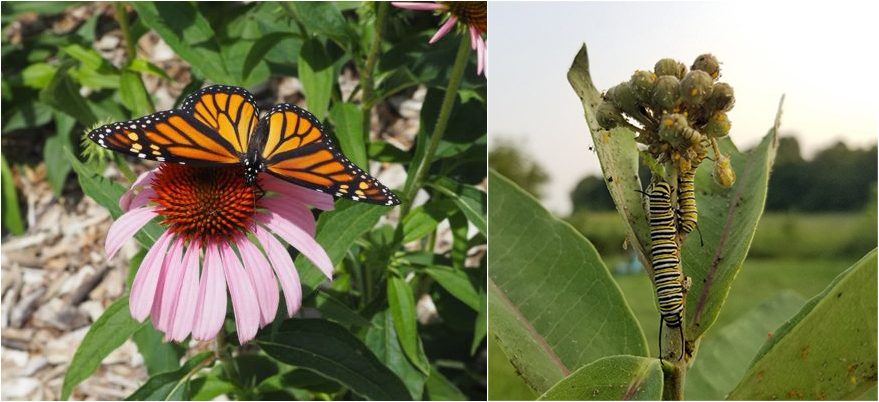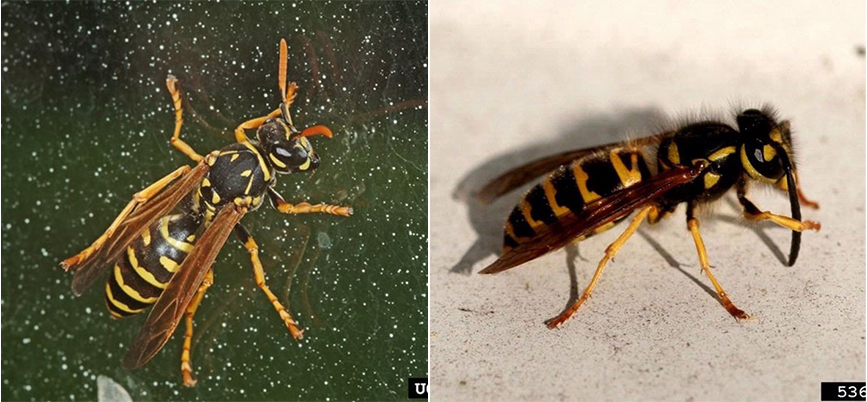Issue 10, September 1, 2022
Tips for Attracting Monarch Butterflies to Gardens and Landscapes

Left: Monarch adult on purple coneflower, Sarah Hughson, University of Illinois at Urbana-Champaign.
Right: Monarch caterpillars on common milkweed, Sarah Hughson, University of Illinois at Urbana-Champaign.
Last month, the migratory monarch butterfly was added to the International Union for Conservation of Nature (IUCN) Red List as an endangered species. IUCN is an international non-profit organization and the world’s leading authority on biodiversity. The IUCN Red List is different than the US Federal Endangered Species list managed by the US Fish and Wildlife Service. Currently, the migratory monarch is not on the US Federal Endangered Species list but will be re-evaluated for endangered status in the future. At this time Illinois applicators are not required to change their operations, but many are wondering what they can do to help our native monarchs.
The following are suggestions for improving monarch gardens based on research by Adam Baker PhD, and presented in a recent Horticultural Research Institute webinar by Dan Potter PhD. Baker’s research looked at factors affecting monarch utilization of garden spaces and factors affecting monarch survival in those spaces. Here are some
Choose a garden location with north-south access:
- In Baker’s research, more monarchs were counted in gardens in locations with north and south access. Since monarchs travel toward the north or south in their migration, access to gardens from those directions is most beneficial. This means that planting a garden along the east or west side of a building or fence is beneficial because it allows monarchs to easily enter the garden from the north or south.
Plant milkweed where monarchs can see it:
Monarchs locate host plants visually, so making sure milkweed plants are easy to see by passing butterflies is key. This can be done by:
- Planting milkweed along the perimeter of gardens
- In research, more monarchs were found on milkweed plants placed along the perimeter of gardens compared to those located in the center or mixed throughout the garden.
- Plant milkweed in structured gardens
- More monarchs were found on milkweed in structured gardens where plants were spaced and separated by mulch compared to gardens with dense mixtures of plants. In dense plantings, non-host plants may grow around the milkweed, making it difficult for monarchs to see and locate the milkweed.
Preferred milkweed species:
- Tall milkweed species were preferred
- More monarchs were found on taller species of milkweed like swamp milkweed, common milkweed and showy milkweed.
- Smaller species are still beneficial to monarch but may not attract as many monarchs. Smaller plants are also great for bee diversity in the garden.
- Nativars were just as helpful for monarchs in gardens
- Nativars are native species that have been bred or cloned to produce showier flowers.
- Research found no difference in the number of monarchs or the development of caterpillars on nativar milkweed compared to the wild-type of the same milkweed species.
- While it is fine to use nativars in gardens, we don’t recommend using nativars in nature preserves or protected areas.
Avoid tropical milkweed
While tropical milkweed is an attractive addition to a garden, it is not the best choice for monarchs. Here are three drawbacks to planting tropical milkweed:
- Tropical milkweed does not dieback at the same time as our native milkweed plants. Milkweed dieback is an important cue that lets monarchs know that it is time to migrate, so monarchs feeding on tropical milkweed may not leave the plants at the right time to migrate successfully.
- Since monarchs are lingering on tropical milkweed plants, their populations can build up and transmit illness, particularly OE (Ophryocystis elektrosirrha). OE is a parasite that can impact the ability to emerge from the pupal casing, ability to fly and migrate properly, and survival. Some infected individuals may have small or crumpled wings.
- In higher temperatures caused by climate change, tropical milkweed may produce higher levels of toxins than native milkweeds and become toxic to monarchs.
Control European paper wasps (Polistes dominula)
- European paper wasps are an introduced species that feed caterpillars to their young. This species is not put off by the distastefulness of monarch caterpillars and may feed on them. Younger caterpillars are more at risk of predation by European paper wasps but larger caterpillars can sometimes be taken.
- European paper wasps look similar to yellowjackets (Vespula spp.).
- European paper wasps build their paper nests in crevices or under overhangs, while yellowjackets nest underground in abandoned rodent holes or other concealed locations.
- European paper wasps have yellow or orange tipped antennae, yellowjackets have black antennae

Left: European paper wasp (Polistes dominula), Joseph Berger, Bugwood.org.
Right: Eastern yellowjacket (Vespula maculifrons), Whitney Cranshaw, Colorado State University, Bugwood.org<
Avoid placing butterfly houses in or around pollinator gardens.
- While butterfly houses are cute, butterflies don’t utilize them.
- Butterfly houses are attractive sites for European paper wasps nests, so butterfly houses may inadvertently lead to monarch predation by European paper wasps.
Monarch Resources:
Monarch Waystations https://monarchwatch.org/waystations/
Monarch Joint Venture: Learn more about monarch biology, create habitat or get involved with community science projects that benefit monarchs https://monarchjointventure.org/
Xerces Society: Learn about pollinator protection, including lists of pollinator plants for your region and other educational materials https://xerces.org/
Primary Research used in this article:
Baker, A.M. and D.A. Potter. 2018. Colonization and usage of eight milkweed (Asclepias) species by monarch butterflies and bees in urban garden settings. Journal of Insect Conservation, 22, 405 - 418. https://link.springer.com/article/10.1007/s10841-018-0069-5
Baker, A.M. and D.A. Potter. 2019. Configuration and location of small urban gardens affect colonization by monarch butterflies. Frontiers in Ecology and Evolution. https://doi.org/10.3389/fevo.2019.00474
Baker, A.M. and D.A. Potter. 2020. Invasive paper wasp turns urban pollinator gardens into ecological traps for monarch butterfly larvae. Scientific Reports, 10, 9553. https://doi.org/10.1038/s41598-020-66621-6
Baker, A.M., C.T. Redmond, S.B. Malcolm and D.A. Potter. 2020. Suitability of native milkweed (Asclepias) species versus cultivars for supporting monarch butterflies and bees in urban gardens. PeerJ 8:e9823. https://peerj.com/articles/9823/
Author:
Sarah Hughson